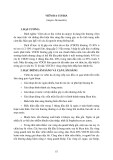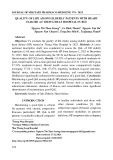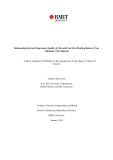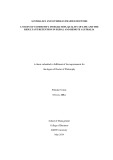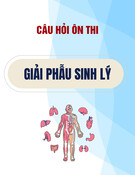
THAI BINH JOURNAL OF MEDICAL AND PHARMACY, VOLUME 16, ISSUE 2 - MARCH 2025
71
1. Thai Binh University of Medicine and Pharmacy
*Corresponding author: Nguyen Thi Kim Dung
Email: dunghungdl79@gmail.com
Received date: 17/02/2025
Revised date: 11/3/2025
Accepted date: 20/3/2025
CLINICAL FEATURES AND ASSOCIATED FACTORS OF ATOPIC DERMATITIS
AT THAI BINH UNIVERSITY HOSPITAL
Nguyen Thi Kim Dung1*, Nguyen Thi Tai Linh1
ABSTRACT
Objective: This study aims to identify the
clinical features and factors associated with atopic
dermatitis (AD) at Thai Binh University Hospital, as
well as to analyze the relationship between disease
severity and quality of life of patients.
Method: A cross-sectional study was conducted
with 225 patients diagnosed with atopic dermatitis
at Thai Binh University Hospital in 2022. Patients
were surveyed on clinical factors, disease severity
using the SCORAD index, and quality of life using
the DLQI scale. Data analysis was performed
using descriptive statistics, correlation, and linear
regression methods.
Results: The results showed a strong correlation
between stress levels and both SCORAD (r = 0.56)
and DLQI (r = 0.35) scores. Furthermore, factors
such as allergic history and stress levels had a
significant impact on disease severity and quality of
life (p < 0.01). Linear regression analysis indicated
that allergic history and stress levels were the most
significant factors influencing disease severity and
quality of life (β = 0.42 and β = 0.25, p < 0.01).
Conclusion: Factors such as allergic history
and stress levels have a significant impact on the
severity and quality of life of patients with atopic
dermatitis. Managing stress and controlling allergic
factors may improve patients’ quality of life and
help manage disease severity.
Keywords: Atopic dermatitis, disease severity,
quality of life, SCORAD, DLQI, allergic history,
stress.
I. INTRODUCTION
Atopic dermatitis (AD) is a chronic dermatological
disease characterized by skin inflammation, itching,
and dryness, affecting various age groups and
genders. The disease often begins in childhood and
can last throughout life, significantly impacting the
quality of life of the patients. According to a study
by Sato et al. (2019) [1], atopic dermatitis is the
most common dermatological disease in children,
with a global prevalence of approximately 15-20%
in children and 1-3% in adults (Sato et al., 2019).
This condition not only causes skin problems but
also deeply affects the psychological state and
daily activities of patients, especially with functional
symptoms such as itching and insomnia.
Atopic dermatitis has a genetic component,
regulated by the interaction between genetic and
environmental factors. A study by Silverberg (2017)
[2] indicated that 50-80% of atopic dermatitis
cases have a genetic basis, particularly in patients
with a family history of other allergic conditions
such as asthma and allergic rhinitis (Silverberg,
2017) [2]. Early detection and treatment of atopic
dermatitis are crucial in preventing complications
and improving the quality of life of the patients.
Atopic dermatitis (AD) is a common condition
in dermatology, particularly at large medical
facilities such as Thai Binh University Hospital.
However, research on the clinical characteristics
and factors affecting the quality of life of atopic
dermatitis patients in provincial hospitals remains
limited. Factors such as family history, functional
symptoms, and disease severity have not been
fully and clearly studied.
The aim of this study is to describe the clinical
characteristics of atopic dermatitis and analyze
the factors affecting the quality of life of patients
at Thai Binh University Hospital. The results of
this research will provide valuable insights into
this condition, while also contributing to improving
diagnostic, treatment, and management practices,
thereby enhancing the quality of life for patients.
II. SUBJECTS AND METHODS
2.1. Subject, location, and study period
2.1.1. Subjects
The study subjects are patients diagnosed with
atopic dermatitis who visited Thai Binh University
of Medicine and Pharmacy Hospital.
Inclusion criteria:
Patients aged ≥ 18 years, diagnosed with
atopic dermatitis, capable of communication, and
consenting to participate in the study.
Exclusion criteria:





